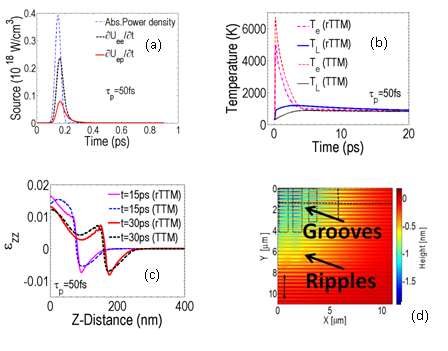MULTISCALE MODELING OF MATERIALS UNDER EXTREME IRRADIATION
Theory & Simulation Installation 3
Simulation tools are offered to
(i) account for the thermal response in terms of high-carrier density excitation
(ii) predict the induced structural modifications.
As an example, the figure in the main page shows: (a) Hydrothermal waves (convection rolls) generated on the surface of the material due to thermal gradients, (b) Spatio-temporal distribution of the lattice (white region corresponds to material removed, while white dashed line indicates the maximum depth of the region that has melted).
One of the important issues that rises when materials are exposed to extreme irradiation conditions generated by various types of electromagnetic sources, including synchrotron sources, pulsed and free-electron lasers is the estimation of the material structural and phase changes. Such changes are inadvertently dependent on material absorption properties, and the irradiation parameters and conditions. In this context, in order to link the anticipated material structural and phase changes with the irradiating source parameters and experimental measurements, a multiscale theoretical modelling toolbox is offered to describe the physical fundamentals and mechanisms that account for the associated experimental observations after single and multiple pulse irradiation at high-carrier density excitation conditions. Such theoretical framework can be applied to predict the induced structural modifications including phase transitions and morphological changes. The multi-scale simulation code comprises the following modules that are material and source parameters dependent:
- Energy absorption (based on results from first principles used to compute the optical properties of the material): spatio-temporal distribution of absorbed energy (Fig.a)/ Finite Difference Finite Domain Schemes,
- Surface plasmon excitations: computation of conditions for excitation, length and lifetime,
- Electron excitation and relaxation processes: computation of electron temperature and equilibration through electron-phonon scattering processes, application of Two Temperature Model (Fig.b),
- Thermal response of the lattice and phase transitions: spatio-temporal lattice temperature distribution and investigation of associated phases transitions (i.e. hydrodynamical effects and solidification)
- Elastic and plastic effects: application of dynamic elasticity equations and coupling with above modules (Fig.c),
- Estimation of phase transition, modification thresholds and morphological changes (Fig.d)
The simulation codes are predominantly designed to run for metals, semiconductors, dielectrics


